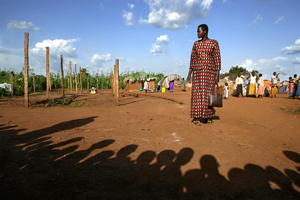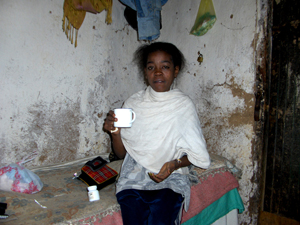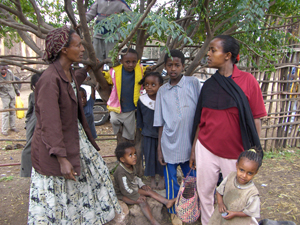KAMPALA, Uganda — The Ugandan government of President Yoweri Museveni has enthusiastically embraced the Bush administration’s approach to fighting HIV/AIDS, which emphasizes persuading young people to abstain from sex rather than the use of condoms. Museveni has derided condoms as “not the ultimate solution” and a “hindrance” to relationships, and in the Ugandan capital of Kampala, billboards for condom brands have been replaced by advertisements touting chastity. In September 2005, Museveni even brought a group of young Ugandans with him on a visit to the United States, where at a Capitol Hill ceremony attended by members of Congress and evangelical Christian pastors, the youths publicly pledged to remain virgins until marriage.
But in Uganda’s Masaka district, about 75 miles southwest of Kampala, plenty of young Ugandans seem to be disregarding their government’s abstinence message. In a grassy field along the shores of Lake Nabugabo, students on school holiday are flocking to a massive dance party put on by local promoters, who charge them 3000 shillings (about US$1.50) to get in. As disc jockeys blast local Ugandan music and American hip-hop, teenagers dance, play volleyball, drink beer and, as the evening progresses, look to find a member of the opposite sex with whom they can sneak off to the seclusion of the nearby woods.
Among those hoping to get lucky is Francis, a short, stocky 16-year-old who favors the same baggy, oversized style of dress that appeals to American teens. He’s heard all about abstinence in school, but he doesn’t put much stock in it. “You can’t abstain forever,” he tells a visiting ICIJ reporter.
Like most Ugandans, Francis knows all too well the risks of HIV/AIDS — his father died of the disease when Francis was 10 — but that hasn’t lessened his own desire to have sex. Francis has learned a little about condoms — not from school, but by reading the instruction leaflet inside a package. He’s admittedly not very conscientious about actually using them; on this particular holiday, he didn’t get to the store before it closed, so he’s going without protection. To him, it’s no big deal. “AIDS is like any other disease,” he says with youthful bravado. “If it is your day to get it, you get it. You start taking drugs and resume your life.”
Abstinence takes precedence
Young Francis exemplifies a growing Ugandan dilemma. After becoming one of the first African countries to be hit hard by the HIV/AIDS epidemic in the early 1980s, Uganda won widespread plaudits as the African success story in combating the disease. By the end of 1992, at the epidemic’s peak, about 18 percent of Ugandans were infected, and in some areas the rate topped 30 percent. But rather than ignoring the peril, as many other heads of state did, President Museveni became one of the first to speak out to his people about the danger of HIV/AIDS and to organize nationwide prevention programs. With international help, Uganda developed a three-pronged, so-called, ABC approach for prevention — preaching “Abstinence” for those who could manage it, encouraging married and co-habiting couples to “Be Faithful,” and providing plenty of “Condoms” to everyone else as a fallback. The strategy worked. By the 2000s, the HIV/AIDS infection rate had dropped to about 6 percent.

In the last few years, coinciding with the advent of the President’s Emergency Plan for AIDS Relief, or PEPFAR, a five-year, $15 billion U.S. initiative to combat AIDS abroad, much has changed. The Bush administration program has pumped desperately needed funds into the impoverished African nation — $90.8 million in 2004, $148.4 million in 2005, and $169.9 million this year. But the U.S. funding came with strings attached. When it came to prevention, school programs were to emphasize abstinence; as one PEPFAR document notes, “Emergency Plan funds may not be used in schools for marketing efforts to promote condoms to youth, and . . . may not be used in any setting for marketing campaigns that target youth and encourage condom use as the primary intervention for HIV protection.”
Uganda’s government has adopted the Bush administration’s no-condoms-for-teens restrictions with zeal — not just out of a desire to please its benefactor, but also because it reflects the conservative religious beliefs of President Museveni and his wife, Janet. (Uganda’s first lady, who promotes abstinence rallies and has talked of conducting a “virgin census” at colleges, said in 2003 that condoms were unnecessary for young people. “I know girls who diet because they want to keep themselves looking good,” she said. “Well, if they can practice self-control in food intake, why can’t they practice self-control in sex?”) As a result, school programs have focused on abstinence. In addition, after complaints by members of the Inter-Religious Council of Uganda, a coalition of the country’s five largest religious institutions, information on the proper use of condoms has been excised from school and youth publications. Recently, the IRCU received a $15 million grant from PEPFAR to run prevention, care and treatment programs.
The increasingly single-minded focus on abstinence for youth alarms both HIV/AIDS activists and Ugandan public health officials, who fear that a whole generation may be at risk. The numbers seem to warrant concern. In the two years since the U.S.-influenced emphasis on youth abstinence began, the rate of new HIV infections in Uganda has nearly doubled, from 70,000 in 2003 to 130,000 in 2005, according to Dr. Kihumuro Apuuli, director general of the Uganda AIDS Commission. And while the infection rate for young people — about 3 percent for those ages 15 to 24 — remains lower than for the population as a whole, there’s growing evidence that large numbers of Ugandan youth are engaging in risky sexual behavior. According to UNAIDS, the Joint United Nations Program on HIV/AIDS, for example, nearly three-quarters of Ugandan males between the ages of 15 to 24 as well as 26 percent of females in that age group report having had sex with a casual partner in the previous 12 months. More disturbingly, only about half reported using condoms the last time they had sex.
“We know that there are students in secondary school who are sexually active,” said a top official in the Uganda AIDS Commission, who spoke anonymously to protect his job. “Refusing to talk to them about proper condom use and expecting all of them to be angels and abstain is like putting our heads in the sand.”
Pressure from outside and within
The Ugandan government’s aversion to condoms isn’t completely new. Back in 1989, an official booklet proclaimed: “The government does not recommend using condoms as a way to fight AIDS.” But government opposition to condom use lessened in the early to mid-1990s as the World Health Organization and other international agencies demonstrated how condoms could be used to help reduce the number of new infections and provided funds to make condoms more readily available. To assuage the opposition of religious leaders, condom promotion messages remained subtle until Bishop Misaeri Kauma, the late chairman of the Uganda AIDS Commission, spoke out strongly in support of condom use. Despite initial opposition to condom promotion from religious groups, an explosion of billboards and pro-condom messages on radio and TV — employing slogans such as “No Glove, No Love” and “Protect Yourself and Your Family” — began to make an impression on Ugandans. With marketing firms pushing brands with names like Lifeguard and Protector, condoms became easier to obtain.
The Ugandan government always preferred to give abstinence and faithfulness the bulk of the credit for the nation’s declining rate of HIV/AIDS prevalence, and persuading Ugandans to change their sexual behavior undoubtedly has made a difference. (According to a government survey, for example, the percentage of 15- to 19-year-old females who are virgins has risen from 38 percent in 1995 to 54 percent in 2004.) But there’s also evidence that condoms played a major role. One U.N. study, for example, showed that the abstinence rate among women increased from 8 percent in 1989 to 13 percent in 2000. During that same period, condom use reported by women grew even more, from 20 percent to 39 percent.
And in some places, condom use may have played a bigger role than abstinence or faithfulness. A study by Columbia University and Johns Hopkins University researchers found that in Rakai, a province in southern Uganda, the major factor in reducing HIV/AIDS prevalence by about one-third from 1994 to 2003 was neither abstinence nor faithfulness — indeed, the percentage of men with multiple sexual partners actually rose slightly during that period. Instead, the only increase in preventive behavior that the researchers could find was in condom use, as 50 percent of men said they consistently used condoms in their extramarital liaisons, compared with 10 percent in 1994. (Another, more macabre factor in the decline in Rakai’s HIV/AIDS prevalence: the death of previously infected people.)
Dr. Sam Okware of the Ugandan Ministry of Health believes it actually was a combination of the three aspects of the ABC approach that helped the country bring the epidemic down to more manageable levels. Okware said he thinks that in large part, that was because ABC made no value judgments, but instead offered a range of options for everyone. “Even in the same individual, in the morning you are on mode A,” Okware told an interviewer in June. “In the evening you are on mode B. And maybe at night, after a small drink, you are on mode C, and vice versa.”
 But in 2003 and 2004, the delicate, often uneasy balance among the three parts of the ABC strategy began to shift. Bush administration officials began working with the Ugandan government to develop a new “emergency plan” for combating HIV/AIDS, with the avowed goal of averting 165,000 new infections over a five-year period, according to PEPFAR documents. The new effort wouldn’t totally exclude condoms — the U.S. would buy and ship 47 million of them in 2005. But their use would be promoted only to a narrow “increased risk” segment of the adult population, including roving fishermen, truck drivers, soldiers, and commercial sex workers and their clientele. (The “social marketing” promotion effort would include putting condoms and literature about HIV/AIDS at bars, nightclubs, truck stops and drugstores and offering counseling through outreach organizations.)
But in 2003 and 2004, the delicate, often uneasy balance among the three parts of the ABC strategy began to shift. Bush administration officials began working with the Ugandan government to develop a new “emergency plan” for combating HIV/AIDS, with the avowed goal of averting 165,000 new infections over a five-year period, according to PEPFAR documents. The new effort wouldn’t totally exclude condoms — the U.S. would buy and ship 47 million of them in 2005. But their use would be promoted only to a narrow “increased risk” segment of the adult population, including roving fishermen, truck drivers, soldiers, and commercial sex workers and their clientele. (The “social marketing” promotion effort would include putting condoms and literature about HIV/AIDS at bars, nightclubs, truck stops and drugstores and offering counseling through outreach organizations.)
“We have erroneously given more prominence to condoms, and this is going to change,” Ugandan Minister for Information Nsaba Buturo explained at the time. “It is now going to be equal treatment.”
Instead, the major focus of the U.S.-Ugandan plan has been to promote the “A,” or “Abstinence,” and “B,” or “Be Faithful,” components of the ABC approach — including an ambitious goal of reaching 9 million young Ugandans in 2006 with the message that the best way to avoid HIV/AIDS is to not have sex. According to PEPFAR documents, the U.S. is funding scores of youth abstinence efforts, including teen advice shows on radio, traveling drama troupes that perform skits about abstinence and “open-air events” designed to attract large crowds.
But the key part of the U.S.-funded youth abstinence campaign is a massive effort to teach abstinence in Uganda’s schools. PEPFAR money goes to print teacher manuals and student handbooks and to develop a classroom curriculum that is reinforced with anti-AIDS clubs and school assemblies. In contrast to the 1990s, when a government policy document said “Correct information on condom use should be provided to young people,” the new student and teacher materials aim to discourage condom use. “Young people in schools are not married and therefore should not indulge in sex,” a teacher resource book advises. “The use of condoms among unmarried young people therefore does not arise. Young people do not need condoms; they need skills for abstaining from premarital sex.” In place of information about proper condom use, students are to rely on self-esteem, patience and the ability to resist peer pressure.
A Ugandan official asserted that the editing out of information about condoms is not so much the result of U.S. pressure — PEPFAR regulations specify that U.S. money may not be used to promote condoms among young people as a primary prevention approach — but rather, at the insistence of the private religious schools that form a significant part of Uganda’s educational system. “There are certain things that you can’t say in faith-based schools,” Ugandan Ministry of Youth and Sports spokesman Aggrey Kibenge told ICIJ. “Things like condoms, which you can’t talk about openly.” He says that religious organizations “did not want any condom information in the handbooks.”
PEPFAR’s coordinator in Uganda, Premila Bartlett, said that instructors using the curriculum “are supposed to provide accurate information about condoms when asked, but do not promote them.”
But others say that in practice, there’s significant pressure to keep condoms out of school discussions. A senior official who works in the Ministry of Health told ICIJ that several years ago she frequently visited schools to talk to students about HIV/AIDS prevention, including the use of condoms. But after the government’s policy shifted sharply toward promoting abstinence only, she was instructed by an official in the first lady’s National Youth Forum to stop talking about condoms during her visits. So “I went to a school and spoke about abstinence and faithfulness,” she recalls. Afterwards, “all the students wanted to know why I had not told them anything about condoms.”
Information about condoms also is disappearing from other sources where Ugandan youths might learn about them. One example is Straight Talk, a newsletter that began in the mid-1990s as a means for children and young people to learn about the ABC approach for preventing HIV/AIDS. While Straight Talk once addressed the full range of ABC options, recent editions of the publication — which receives some U.S. funding from PEPFAR — no longer mention condom use. An official with the foundation that publishes Straight Talk, who asked not to be identified for fear of offending the publication’s U.S. underwriters, ascribed the change to “self-censorship.”
“Throughout last year, we were operating under pressure,” he said. “Everyone knew that the first lady was advocating for abstinence and faithfulness, so no one wanted to stand out for promoting condoms.”
Awareness, availability of condoms scarce
Some critics say that the emphasis on the abstinence part of ABC by the U.S.-Ugandan effort is equivalent to a moral condemnation of condom use. “It seems to suggest that those who abstain are the good people,” said the Rev. Canon Gideon Byamugisha, a prominent HIV/AIDS activist. “Those who are faithful are weak but also fine, while those who use condoms are those living in sin.”
PEPFAR official Bartlett countered that the program isn’t anti-condom but is merely targeting high-risk adult groups — truck drivers, the military, commercial sex workers — in its condom promotion efforts.
Many Ugandans disagree with the new abstinence-only strategy for youths. A government-conducted survey, for example, shows that roughly six in 10 adults agree that children between the ages of 12 and 14 should be taught about using condoms.
“As far as I am concerned, everyone in Uganda is at high risk,” the Straight Talk Foundation official said. “You can restrict condom use to prostitutes and truck drivers, but those prostitutes are sleeping with married men, and those truck drivers are sleeping with married women when their husbands go away. A student who abstains in January may become sexually active in March. Sex is not always a planned activity. It is better to give people all the information they need so that they can make informed choices.”
But distribution of information about condoms isn’t the only problem. Though 71 percent of young Ugandan males and 49 percent of females told a government survey that they knew where they could obtain condoms, the price of commercially available brands — about 27 cents for a pack of three, in a country where the average Ugandan lives on less than $1 a day — often makes it difficult for young people to buy them at the local drugstore. Instead, they may have to rely on free condoms handed out by the government at health centers — that is, providing that some are available. In summer 2005, the media reported that Uganda experienced a condom shortage, after the government decided that a leading brand had poor quality control and ordered a recall — and then the government levied new taxes on imported condoms, making the replacements more expensive. The Ugandan government denies that a shortage occurred.
Though the recall is over, the American Prospect magazine recently reported that tens of millions of condoms are languishing in warehouses, awaiting government rebranding so that the public will be confident they are safe. “I’ve spoken with many young people who have tested positive,” Ugandan HIV/AIDS activist Beatrice Were was quoted as saying. “And the health centers simply have no free condoms to give them.”
The U.N.’s special envoy for HIV/AIDS, Stephen Lewis, has gone so far as to blame the condom shortage on the U.S. preference for promoting abstinence. “To impose a dogma-driven policy that is fundamentally flawed is doing damage to Africa,” he told the Associated Press in the summer of 2005. (Deputy U.S. global AIDS coordinator Mark Dybul, in response, called Lewis’ charges “nonsensical,” and then Ugandan Health Minister Jim Muhwezi denied that there was a shortage. “There seems to be a coordinated smear campaign by those who do not want to use any other alternative simultaneously with condoms against AIDS,” he said.)
Meanwhile, back at the holiday bash on Lake Nabugabo, the condom crisis puts teenagers such as Sarah in an increasingly difficult position. “I’m scared of catching AIDS,” admits the slim 17-year-old high school student, clad in a simple skirt and T-shirt, who is waiting to meet up with a boyfriend. Like Francis, she’s seen the disease’s devastation from painfully close up. Her aunt contracted the virus, and Sarah had to help care for her; the aunt subsequently died. Sarah tells ICIJ she tried to practice abstinence, but after she got peer pressure from other sexually active girls and her boyfriend accused her of not loving him enough to have intercourse, she gave in. She says she’s faithful to her boyfriend, but since he goes to a different school in another part of the country, she’s not really sure that he doesn’t fool around with others. So Sarah has insisted that he use a condom when they have sex. So far, at least, he’s going along.




